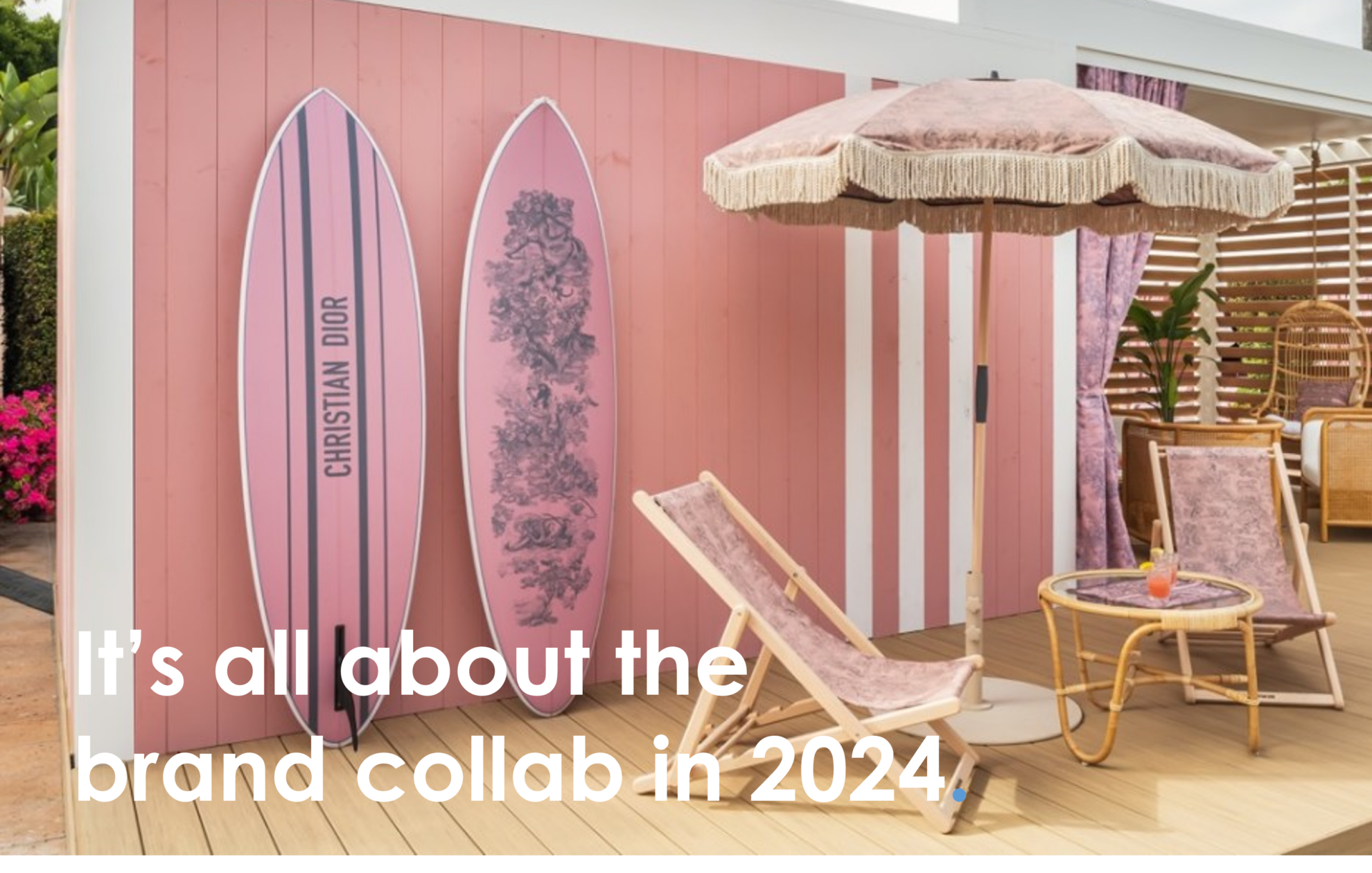It’s all about brand collabs in 2024.

Christie Decker – Event Director – Sense New York.
2023 brought us a barrage of unlikely brand collabs. Heinz collaborated with Absolut for a limited-run vodka sauce that used genius marketing to go absolutely viral. Patrick McDowell debuted a collaboration with Lee Jeans at London’s Spring 2024 Fashion Week, utilizing upcycled denim for a sustainable high-fashion collection. Barbie collaborated with, well, everyone, in every industry.
Why brand collabs?
According to a new survey report by Visual Objects, 71% of consumers enjoy co-branded partnerships, and Google data shows an 1150% increase in the term “brand collaborations” in the past 10 years. A good collab can bring in new customers, raise your reputation and garner epic social media attention. Pairing with the wrong brand in a collab? This can be devastating to even the most well-established brands (ahem, Adidas x Yeezy).
Luxury brands especially have embraced collaborations in the past few years. This strategic approach has proven to be immensely beneficial, enabling them to tap into new and diverse audiences. With 81% of Gen Z saying that brand partnerships lead them to brand re-appraisal, this collaborative tactic has proven its remarkable capacity to broaden the brand’s accessibility to a larger audience that previously might have perceived the brand as “out of reach”.
In forging these connections with a new audience, it takes more than just exceptional products. It’s about telling a story within that collaboration and crafting a unique experience for the consumer—one that stirs emotions and feels personal. Here are some things to look for in a successful brand collaboration.
Brand alignment
One of the recent standout successes in brand collaborations is the North Face x Gucci partnership. Initially teased towards the end of 2020 and hitting shelves in 2021, the collection swiftly became a resounding success, repeatedly selling out. Building on this triumph, they launched a second collection in 2022, which also garnered remarkable acclaim.
However, the collaboration’s triumph extends beyond the vibrant, 70’s-inspired floral designs. Both brands attribute their success to a natural partnership founded on shared values of adventure, freedom, respect for nature, and, above all, the spirit of exploration.. The concept of the ‘spirit of exploration’ was the driving force behind the collaboration, perfectly timed for its 2021 release when the world was eager to get back to the outdoors after the 2020 pandemic.
For a collaboration to thrive, it’s crucial that it aligns with the fundamental values of both brands, ensuring authenticity. When brand values resonate, it fosters a genuine and meaningful connection between loyal customers and a compelling marketing message.
Experiential
When it comes to luxury retail brands, it is no secret the classic brick-and-mortar retail model is a dying concept. Brands need to re-think the in-person shopping experience, and make it just that — an experience. Collaborations can be a tool to help reimagine retail marketing by partnering with a brand who excels in experiences.
A pinnacle example of such partnerships is the fusion of a luxury retail brand with a high-end hotel. In an era where consumers increasingly prioritize experiences over material possessions, merging luxury goods with a lavish and immersive environment provides the ultimate shopping setting. In 2023, Dior debuted the “Dioriviera” capsule collection in a pop-up boutique at select luxury hotels around the world. The US location was situated in the iconic Beverly Hills Hotel, taking over the pool area and transforming the upstairs into the upscale boutique.
Visitors were treated not only to the exquisite Dior merchandise but also immersed in the hotel’s top-notch service standards, seamlessly intertwined with luxurious Dior-style embellishments. This collaboration epitomized the ultimate retail destination, seamlessly blending high-class service with opulent retail experiences.
Meaningful
Without a meaningful story behind the collaboration, the partnership could be portrayed as superficial, merely crafted for marketing gains and financial motives. When Dior and Birkenstock unveiled their collaborative shoe line in 2022, they introduced a narrative that justified the collaboration’s relevance. The collaboration served as a subtle tribute to Monsieur Dior’s mother, who instilled in him a love for horticulture during his upbringing. This heartfelt connection, along with the thoughtful design, added a deeper, more meaningful dimension to their partnership.
Communicating the reasons behind the collaboration between two brands holds significant importance for consumers. It’s crucial not to overlook this aspect in both marketing strategies and design implementation. Highlighting these details ensures that the purpose behind the collaboration is multifaceted and significant, rather than being perceived as solely driven by financial motives. Layering the narrative behind the partnership enriches the story and makes the collaboration more meaningful to consumers.
Imaginative
The Nike x Tiffany collaboration faced a wave of criticism in 2023 due to its lack of imaginative design. As two powerhouse and iconic brands, the anticipation for the sneaker’s innovation was sky-high, but unfortunately, the final result missed the mark. The outspoken and passionate sneakerhead community didn’t hold back in expressing their disappointment.
When presented with a brand collaboration opportunity, embracing the unique and distinct elements of the partnering brand is key. Don’t hesitate to dive into the details that sets the other brand apart from your own. Collaboration isn’t about staying within the boundaries of your brand guidelines; it’s about daring to venture beyond and incorporating the qualities of another brand to craft something memorable and extraordinary.
Don’t know where to start with brand collabs? Speak to us. We might know a brand looking to do something unique with you.